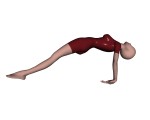 Look around. Is your work…well, is it ‘work’ and not one exciting, innovative creation after another? Could your material be so predictable that you are in what dancer/choreographer Twyla Tharp calls “a false start?” Tharp defines a “false start,” or a creative rut as different from being blocked and most definitely different from being in a good groove. “A rut is the part of the journey where you’re spinning your wheels, spitting out mud behind you, splattering other people, and not going anywhere. You know you’re in a rut when you annoy other people, bore your collaborators and supporters, fail to challenge yourself, and get the feeling that the world is moving on while you’re standing still. You may also feel that you’ve been here before; déjà vu, with some flop sweat on the side, is a sure sign of a rut. Perhaps the surest sign is a feeling of frustration and relief when you’re done (“Boy, I’m glad that’s over!”) rather than anticipatory pleasure (“I can’t wait to get back here tomorrow.”) Call it consistency, following a syllabus, or teaching a “graded system,” you know when your work is dry and uninspired. It happens to everyone. Don’t worry. There are some simple ideas to help refresh your artistry and renew the feeling of, “I love being me!” that every creative person knows.
Look around. Is your work…well, is it ‘work’ and not one exciting, innovative creation after another? Could your material be so predictable that you are in what dancer/choreographer Twyla Tharp calls “a false start?” Tharp defines a “false start,” or a creative rut as different from being blocked and most definitely different from being in a good groove. “A rut is the part of the journey where you’re spinning your wheels, spitting out mud behind you, splattering other people, and not going anywhere. You know you’re in a rut when you annoy other people, bore your collaborators and supporters, fail to challenge yourself, and get the feeling that the world is moving on while you’re standing still. You may also feel that you’ve been here before; déjà vu, with some flop sweat on the side, is a sure sign of a rut. Perhaps the surest sign is a feeling of frustration and relief when you’re done (“Boy, I’m glad that’s over!”) rather than anticipatory pleasure (“I can’t wait to get back here tomorrow.”) Call it consistency, following a syllabus, or teaching a “graded system,” you know when your work is dry and uninspired. It happens to everyone. Don’t worry. There are some simple ideas to help refresh your artistry and renew the feeling of, “I love being me!” that every creative person knows.
If the inspiration inclination has temporarily slipped away and writing another page feels like pulling teeth (your own,) it could be a simple matter of needing to “fill the well” as writer Julia Cameron refers to in her book “The Artist’s Way.” Cameron says that the artist’s brain relies on images and that creativity is sometimes blocked or stymied by a lack of artistic brain food. Cameron recommends regular “artist dates” with yourself to “restock the pond” of artful ideas you seem to be lacking. For an artist date, you simply schedule yourself to attend a thought provoking artistic event like a gallery opening or orchestra concert and ingest the sensations all around to help replenish your own source of creative energy. Cameron suggests a habitual practice of artist dates until you understand the ebb and flow of your creativity and how to use the work of other inspired creators to support your own creations.
When I first tried the regular artist date, it annoyed me because I felt like I was being taken away from my own work. Cameron and Tharp both claim that resistance is a sure sign that a respite is most assuredly the best medicine. After a year of consistently attending art shows, poetry readings, and independent film showings, I noticed a rush of recurrent creativity to the point where I can hardly keep up with myself today! I heard a lecture by children’s author Phyllis Reynolds Naylor recently who summed up how I feel. Someone asked her what she did for writer’s block. “I don’t have writer’s block,” she said. “I have so many ideas floating around in my head all the time that I have writer’s diarrhea!” I now have a habit of enjoying the work of other artists and I’m positive it contributes to my never-ending flow of creativity and ideas.
Inspiration is always available to the artist who understands that creativity is a process dependent on many details. Here are some ideas to consider.
Low budget
1) Read books and magazines on creativity.
2) Start a journal. You will be amazed at the creative freedom you can experience from a regular habit of journaling.
3) Find an online community of artists and communicate.
4) Attend free art events like gallery showings, outdoor concerts, and crafts fairs.
Medium budget
1) Take classes from another local teacher. Learning rejuvenates the creative spirit.
2) Analyze the work of other artists. Take pencil and paper and write down what you see or read in videos and books and dissect the creativity of others. Explain to yourself why they did what they did, and then how you would have done it differently and why.
3) Attend poetry readings, art shows, etc. at the local gallery or coffee shop.
4) Cruise through a history museum or see a local theatre production.
High budget
1) Travel to an artist’s retreat or big city where art is revered and the process is respected. Take part in performances, conferences, workshops, and activities that allow you to deeply experience the art.
2) Take college courses at home or far away that will expand your appreciation of creativity.
There are five primary areas of practice to the Writer Wellness plan. Every other week I will post an idea for relaxation (Monday Meditation,) creative play (Tuesday Tickle,) fitness and exercise (Wednesday Workout,) journaling and misc. (Thursday Thought,) and nutrition (Friday Feast.)
Meanwhile, remember to look for a digital or print copy of Writer Wellness, A Writer’s Path to Health and Creativity at Who Dares Wins Publishing, http://whodareswinspublishing.com.
And check out these great blogs for ideas to keep your writing and publishing healthy and prosperous.
http://writeitforward.wordpress.com/ Bob Mayer
http://jenniholbrooktalty.wordpress.com/ Jenni Holbrook
http://warriorwriters.wordpress.com/ Kristen Lamb
http://inspiration4writers.blogspot.com/ Inspiration for Writers, Inc.
Be well, write well.






